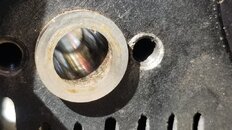I tore my compressor apart for some maintinence. I've been meaning to do it for a while. Everything (to me) looks pretty good except for the top of the 3rd stage cylinder. Per the post linked below, Iain said the 3rd stage is made out of hardened steel. What can I do (if anything) to fix this? What could it be from? It looks like either some type of buildup or possible corrosion, but I'm not really sure.
If anyone has been following my other threads on the Rix I was having some blowby from the 2nd stage piston as well as some air leaking from the 3rd stage back into the 2nd. When I would turn it off I always got the blow by, but every onence in a while my 2nd stage OPV valve would also blow meaning the 3rd stage head was leaking some back into the 2nd stage. When running my 2nd stage pressure was just slightly above speck after ~ 3000psi.
@iain/hsm if you're there any guidance would be much appreciated!!!! Hope all is well with you!
If anyone has been following my other threads on the Rix I was having some blowby from the 2nd stage piston as well as some air leaking from the 3rd stage back into the 2nd. When I would turn it off I always got the blow by, but every onence in a while my 2nd stage OPV valve would also blow meaning the 3rd stage head was leaking some back into the 2nd stage. When running my 2nd stage pressure was just slightly above speck after ~ 3000psi.
@iain/hsm if you're there any guidance would be much appreciated!!!! Hope all is well with you!
Two options on the bronze liners, maybe three and yes you are right it's the 2nd stage in the photo.
First option with the bronze liner is leave them alone that allows the PTFE film that has been deposited onto the liner to increase the tribology factor and reduce the friction factor.
Option two: Just "glaze bust" the surface of the liner with a light wet 600-1200 grit paper on your finger
and achieve a cross hatch patching right turn in, left turn out. LIGHTLY
This removes the "glaze" and makes fresh microscopic grooves for the PTFE off the compression and rider ring to fill and achieve a better surface dynamic by having both the piston and the liner in effect PTFE coated. This is the preferred method but needs care.
Option three is using a small cylinder honeing tool a bit over kill but ensures concentricity and a linear bore.
The in the field method is number two by finger and no gloves using a 1200 grit wet and dry. When you burn your finger you know your either rubbing too hard or been at it too long or your putting too much pressure on the side walls.
While you are at it with old compressors I have assumed you have first taken the head off and have a clear hole through the liner each stage, easier to clean out after your done, easier to inspect.
But most important is to run your finger if you have the skin still on and not blistered down the bore on stages 1 and 2 especially at the point where the piston stops at TDC (Top dead centre) and feel if there is a worn ridge around the inside of the piston liner.
We would use a 3 point bore micrometer in the workshop to measure this but I'm aware this is not in our Field Service Manual and way to expensive tools for home builders so you need to judge for any wear in the liner or excess in concentricity by feel.
From memory its a 3M 7447 scotch bright rectangular pad Aluminium oxide brown in colour and a little water nothing else, clean with a wet clean paper towel and dry using dry paper or just leave to dry
The 3rd stage liner is an expensive hardened steel cylinder ground to a very high tolerance and heat treated hardened. I would leave it alone and don't dick with it.
I will keep this to just In the Field Service stuff and using simple hand tools but for context we would in the workshop also do a PMI (positive material inspection) on the hard metal pressure parts just to ensure the clients didn't stick on the odd nut and bolt part out of Home Depot.
PHOTOS Shows a Thermo Fisher SCIENTIFIC Portable x-ray positive material identification tool we use on the parts, in effect an x ray of the parts showing the material content and comparing the results with a "library" of our know parts of materials used. Its not that good as a alcohol breath test analyser.
View attachment 762564




